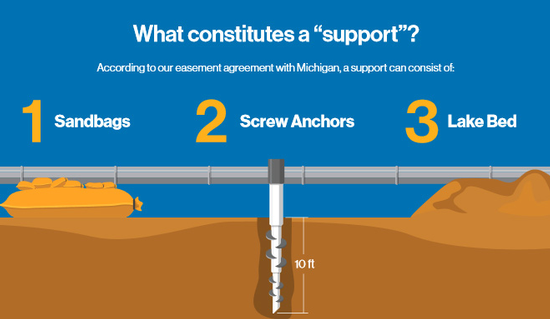MI Pipeline Integrity Questioned Again
MONDAY, JUNE 12, 2017
Enbridge Energy’s Line 5, a 64-year-old liquid pipeline that runs under Michigan’s Straits of Mackinac, is under scrutiny again after documents revealed that underwater stretches up to 286 feet were unsupported for years, in violation of easement stipulations.
MLive reported recently that documents associated with Enbridge’s 2016 settlement with the Department of Justice, citing inspection reports reaching back nearly 15 years, indicate that in more than 200 instances, stretches of pipeline over gaps in the lake floor have gone without the proper support.

 |
| © iStock.com / Dough4537 |
|
Enbridge's Line 5 liquids pipeline runs under Michigan's Straits of Mackinac. |
The original design called for unsupported stretches of no longer than 140 feet, according to reports, but the 1953 easement agreement took a more conservative tack, requiring that no stretch longer than 75 feet go unsupported. Enbridge has reportedly added supports to any spans that exceeded the allowable length.
According to Enbridge, the company added four new screw anchors in 2016 to support areas where stretches of greater than 75 feet were unsupported due to erosion. After those were installed, the company said the total number of anchor supports on the pipeline under the Straits was 126, and Enbridge has plans to add 18 more “as a proactive measure.”
Critics have undertaken efforts to get Line 5 shut down over fears of a breach that could damage the Straits. Earlier this year, Enbridge denied reports of coating holidays on the underwater stretch of the pipeline, admitting that an outer coating had some areas of delamination—but noting that the underlying coatings were intact, and in such a situation, repairs were not necessary.
Pressure Testing
Late last week, the pipeline was undergoing pressure testing, with water pumped through the line at 1,200 psi, about twice the pressure at which liquids—crude oil and liquid natural gas, used for propane production—generally move through the pipeline.
 |
| Enbridge Energy |
|
According to Enbridge, the company added four new screw anchor supports to the underwater pipeline in 2016. |
The pressure testing, reportedly the first of its kind on the pipeline since its construction, is part of the DOJ settlement, reached last year in response to the 2010 spill on Enbridge’s Line 6B, also in Michigan, and a separate spill that year in Illinois. The 6B rupture led to a release of at least 843,444 gallons of oil, according to the EPA.
Enbridge: Integrity Not Compromised
An Enbridge spokesperson told the Detroit Free Press that the company’s inspection reports and data from the Pipeline and Hazardous Material Safety Administration confirm that Line 5’s integrity was not compromised by the periods of time when longer stretches of the underwater pipeline were unsupported.
MLive, though, spoke with retired engineer Edward Timm, who authored an independent report on Line 5 earlier this year, published by the National Wildlife Federation; Timm expressed worry about the effect that the unsupported stretches may have had on the overall pipeline’s integrity. "Clearly, there was a huge period of time when Enbridge just ignored this thing,” he told the news outlet.
Timm’s report, published in March, questions the coatings originally used on Line 5, asserting that Bechtel, which built the pipeline, likely used a field-applied asphalt enamel coating system that at that this point is likely “compromised or missing on many areas of the pipe.” While the original order called for a coal tar enamel coating, Timm says it is unlikely that material was actually used, because of health concerns around field-applying coal tar.
Enbridge notes that Line 5 has never experienced a leak in its over 60 years in service.
Tagged categories: Delamination; Environmental Protection; Health & Safety; Oil and Gas; Pipelines







